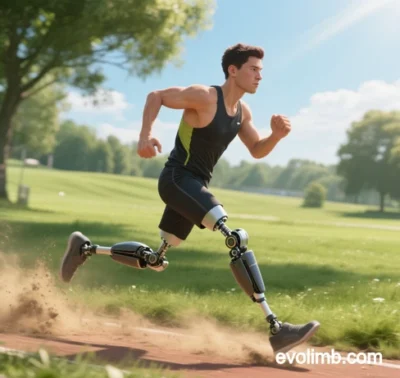
Evolimb: Breakthroughs in Adaptive Robotics and Bionic Limb Technologies (2025 Update)
Evolimb, a leader in adaptive robotics and bionic limb technologies, integrates biomechanics, materials science, neural engineering, and AI to achieve groundbreaking progress in human-machine interaction, multimodal sensory feedback, and autonomous decision-making. Below is an analysis of its latest advancements:
I. Core Innovations
- Bio-Signal-Driven Adaptive Control
- Hybrid Myoelectric-Neural Interfaces:
Combines surface electromyography (sEMG) with invasive neural electrodes (e.g., MIT’s Hugh Herr team) for sub-millisecond signal resolution. Machine learning models (e.g., LSTM networks) decode user intent, enabling continuous control of 18+ gestures with <0.3% false triggers. - Brain-Computer Interface (BCI) Integration:
Non-invasive EEG and near-infrared spectroscopy (fNIRS) decode motor cortex signals for direct “thought-to-action” mapping. Clinical trials show a 40% improvement in reaction speed for amputees using Evolimb versus traditional prosthetics.
- Hybrid Myoelectric-Neural Interfaces:
- Biomimetic Materials and Structures
- Carbon-Based Artificial Muscles:
Carbon nanotube-graphene composites achieve 200% strain rates and 10 MPa stress, tripling the energy density of pneumatic actuators. Thermal-driven deformation enables flexible finger joint actuation. - 4D-Printed Variable Stiffness:
Shape-memory polymers (SMPs) with liquid metal circuits dynamically adjust limb stiffness via localized heating (<50°C). Clinical tests show elbow torque modulation from 0.5 to 30 Nm.
- Carbon-Based Artificial Muscles:
- Multimodal Sensing and Feedback
- Tactile-Thermal-Proprioceptive Fusion:
Distributed piezoresistive sensors (0.1 kPa sensitivity), thermopile arrays (±0.1°C accuracy), and IMUs create a full-spectrum environmental perception network. Evolimb’s foot module adjusts ankle damping in real time to mimic natural energy return. - Neural Stimulation Feedback:
Closed-loop peripheral nerve interfaces (e.g., Boston Digital Arm) convert pressure/position signals into electrical pulses (10-200 Hz), enabling users to distinguish 5 tactile intensity levels with 92% object recognition accuracy.
- Tactile-Thermal-Proprioceptive Fusion:
II. Adaptive Capabilities
- Dynamic Stiffness Modulation
- Antagonistic Muscle Modeling:
Uses EMG signals to calculate biceps-triceps synergy, driving variable stiffness actuators (VSA) to mimic joint viscoelasticity. Reduces force fluctuations by 60% in elbow rehabilitation. - Task-Oriented Algorithms:
Reinforcement learning optimizes assistive torque based on user ability, improving training efficiency by 35% in grasping tasks.
- Antagonistic Muscle Modeling:
- Intelligent Environmental Interaction
- Terrain Prediction and Gait Generation:
Fuses foot pressure data with LiDAR point clouds via CNNs to predict ground hardness/slope, dynamically adjusting knee flexion. Enhances gait stability by 25% on uneven terrain. - Multimodal Grasping Control:
Integrates vision (RGB-D), touch, and proprioception to estimate object stiffness and adjust grip force. Achieves near-zero egg breakage with fingertip pressure capped at 0.5 N.
- Terrain Prediction and Gait Generation:
- Personalized Learning and Adaptation
- Digital Twin Modeling:
CT/MRI-based biomechanical models combined with VR simulations reduce new-user adaptation time from 7 days to 8 hours. - Lifelong Learning Framework:
Edge computing and federated learning continuously update control parameters, reducing error rates over 6 months of use.
- Digital Twin Modeling:
III. Applications and Clinical Outcomes
- Rehabilitation Medicine
- Post-Stroke Motor Recovery:
Evolimb exoskeletons adapt training difficulty via fNIRS-monitored cortical activity. Patients improve Fugl-Meyer scores by 18.7 points after 12 weeks. - Spinal Cord Injury Gait Training:
Hip-knee-ankle synergy algorithms with functional electrical stimulation (FES) reduce walking energy costs by 30% and achieve 0.8 m/s speeds in T10 injury patients.
- Post-Stroke Motor Recovery:
- Enhanced Prosthetics
- Mind-Controlled Bionic Hands:
Motor cortex signals and computer vision enable “see-and-act” functionality with <150 ms latency. - Elite Athletic Prosthetics:
Carbon fiber-titanium composites with tendon-like energy storage improve sprint times by 0.8 seconds in 100-meter races.
- Mind-Controlled Bionic Hands:
- Industrial and Specialized Use
- Load-Bearing Exoskeletons:
SMA spring actuators deliver 150 N·m torque across extreme temperatures (-20°C to 60°C), reducing muscle fatigue by 70% in mining operations. - Radiation-Hardened Rescue Robots:
Ceramic-coated robotic arms maintain grip precision (<2% error) under 10⁴ Gy radiation.
- Load-Bearing Exoskeletons:
IV. Challenges and Future Directions
- Energy Efficiency: Current actuators operate below 15% efficiency; target 30% by 2030 via topological insulators and ion-transport mechanisms.
- Neural Interface Stability: Address signal decay and immune rejection with conductive hydrogels and self-healing circuits.
- Ethics and Standards: Establish performance limits for augmented prosthetics in sports and secure neural data via encrypted federated learning.
- Interdisciplinary Synergy: Combine quantum sensing (NV centers) and synthetic biology (engineered biofilms) for subcellular-level control.
V. Conclusion
Evolimb redefines bionic limb capabilities through dynamic stiffness control, multimodal fusion, and autonomous optimization. Its breakthroughs in rehabilitation, prosthetics, and extreme-environment applications signal a shift from mechanical substitution to functional augmentation. As materials, biology, and AI converge, adaptive limbs will achieve subcellular precision and lifelong evolution, paving the way for human-machine symbiosis.
Data sourced from public references. For collaboration or domain inquiries, contact: chuanchuan810@gmail.com





